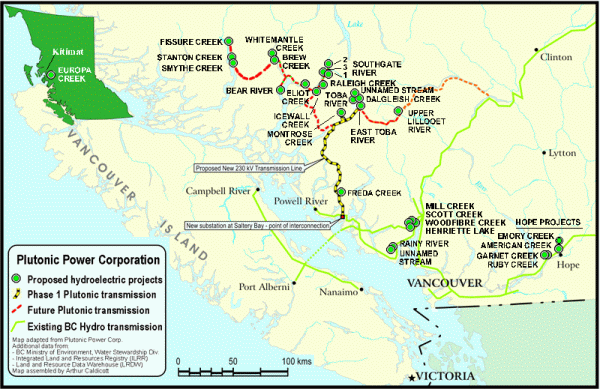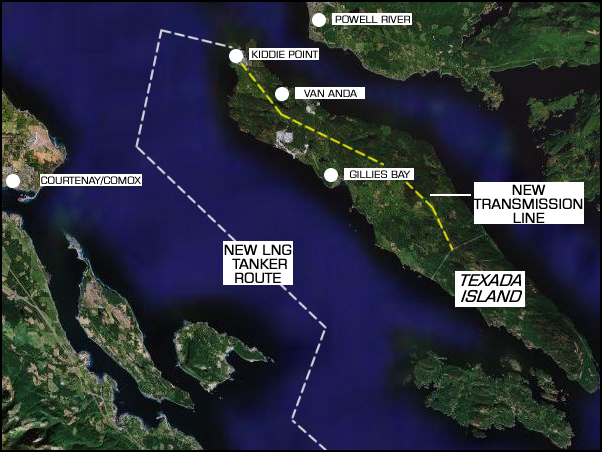

Directors grill power experts
COMMENT: Transmission lines are an essential part of any power project, whether it's small hydro located miles beyond the ends of BC's southern coastal inlets, as shown in this map of Plutonic Power Corp's "Green Power Corridor" or WestPac LNG's Texada Island project.
Unfortunately, the recognition of the environmental, aesthetic, land use and economic impacts of transmission lines comes too late - because, of course, talking about them draws attention to them. Gosh. Why would a company want to do that? Just upsets people.
With dozens of electricity purchase agreements already issued by BC Hydro, and possibly hundreds more to come, the Sunshine Coast Regional District and the Powell River Regional District risked the wrath of Victoria, and brought a bunch of bureaucrats to Powell River to talk about the issue.
"Risk the wrath?" When the Squamish-Lillooet Regional District had the temerity to refuse zoning approval for a small hydro project at the confluence of Ashlu Creek and the Squamish River (a hop, skip and a jump north of the town of Squamish), Victoria removed the zoning authority of regional districts on Crown land. That was Bill 30 in 2005, one of the Liberal government's "give 'em the finger" moments to illustrate how little was meant by the grand gestures in the Community Charter.
If local governments get too ornery about transmission lines, the boot could stomp again.
Or they could simply be ignored, as local government and other interested groups have been, when asking for consultation and input to policy development with respect to the small hydro orgy the provincial government has unleashed.
All of this - Bill 30, tranmission lines, small hydro - is covered brilliantly in Arthur Caldicott's Rivers of Riches, published in Watershed Sentinel in January 2007.
Directors grill power experts
Laura Walz, Editor
Powell River Peak
October 26, 2007

POWER LINE: Plutonic Power Corporation's East Toba-Montrose Creek project includes a 145-kilometre transmission line that connects to a substation at Saltery Bay.
A panoply of government officials travelled to Powell River to meet with Powell River Regional District (PRRD) directors about the increasing number of independent power projects (IPP) in the area.
Representatives from the provincial ministry of energy, mines and petroleum resources, the Integrated Land Management Bureau, BC Hydro, BC Transmission Corporation (BCTC) and WorkSafe BC attended a regional district planning committee meeting on October 16.
PRRD requested the agency meeting to discuss who is taking responsibility for regulating the number, size and location of power lines associated with the growing number of proposed projects, and whether the province is prepared to conduct the necessary higher level planning and coordination required to minimize the number and location of the lines.
David Rafael, a planner from the Sunshine Coast Regional District (SCRD), also attended the meeting. There are 50 proposed IPP sites in the SCRD. "We weren't expecting this gold rush of applications," he said. "Power lines are a big issue for us."
SCRD has adopted a policy similar to one adopted by the Squamish-Lillooet Regional District in 2003. Both policies outline how the two local governments manage IPPs through land-use plans, official community plans and zoning bylaws. Both also require companies developing IPPs to contribute benefit payments to them.
Neil Banera, director of independent power projects policy and operations at the Ministry of Energy, Mines and Petroleum Resources, explained that there are 10 projects in the PRRD for which the ministry has received applications, or for which water licences have been issued. Plutonic Power Corporation has a proposed Green Power Corridor consisting of 34 projects, but the bulk are located in the Comox-Strathcona or Mount Waddington regional districts.
Banera also distributed a document, which outlines how local governments and the public can participate in regulatory processes for IPPs.
Joanne McKenna, BC Hydro's manager of IPP engagement and power acquisitions, said the mechanism that starts the process is BC Hydro's call for power, and that projects are staggered as a result. She agreed that some companies have a gold rush mentality and they are staking claims. "That is an issue," she said.
PRRD planner Don Turner said staggered projects and the way information was coming into the regional district was inconsistent, meaning good land use decisions can't be made. He pointed out if Plutonic's transmission line had been sized correctly on day one, it could serve all the potential projects.
James Ko, from BCTC, said he shared the concerns being raised and agreed that integrated planning is "the way to go." But he also said stepping up the capacity of a power line cost several million dollars and "somebody has to put out that money." The regional district should ask companies with proposals if they have done an inter-connection study, he said, and PRRD could encourage companies to share transmission lines.
Colin Palmer, regional board chairman and Electoral Area C director, asked if the province would consider a moratorium on IPPs until local governments could "thrash out the whole issue."
Banera said that the current approach through a provincial call for power was an attempt to distribute the benefits of the projects throughout the province, and what was being suggested pertained to one geographic area only.
Electoral Area A director Patrick Brabazon said PRRD did not receive a referral on Plutonic's transmission line. "We have no referral for tenure on that several thousand hectares of land that has been alienated from our local economy, " he said.
Banera had mentioned benefits, Brabazon said, but he wanted to look at penalties. "We're losing thousands of hectares from the TFL [tree farm licence]," Brabazon said. "Plutonic is boom and bust. In three years, there will be four to five guys clearing the power line. Meanwhile the local forestry economy suffers."
During the consultation phase of projects, companies have to address issues that are raised, and explain how they are being addressed, McKenna said. "The process is evolving," she said. Land use plans, such as a land and resource management plan, help in locating projects and transmission lines, McKenna added. "If we know there is a no-go zone, we won't go there," she said.
Banera said the preliminary referrals that local governments receive about proposed projects are a "heads up." He also said agencies recognize and accept the concerns that were raised. "We too want a sustainable IPP sector," he said. "How can we proceed in relation to the processes that exist? We may have to do things differently."
Posted by Arthur Caldicott on 26 Oct 2007
